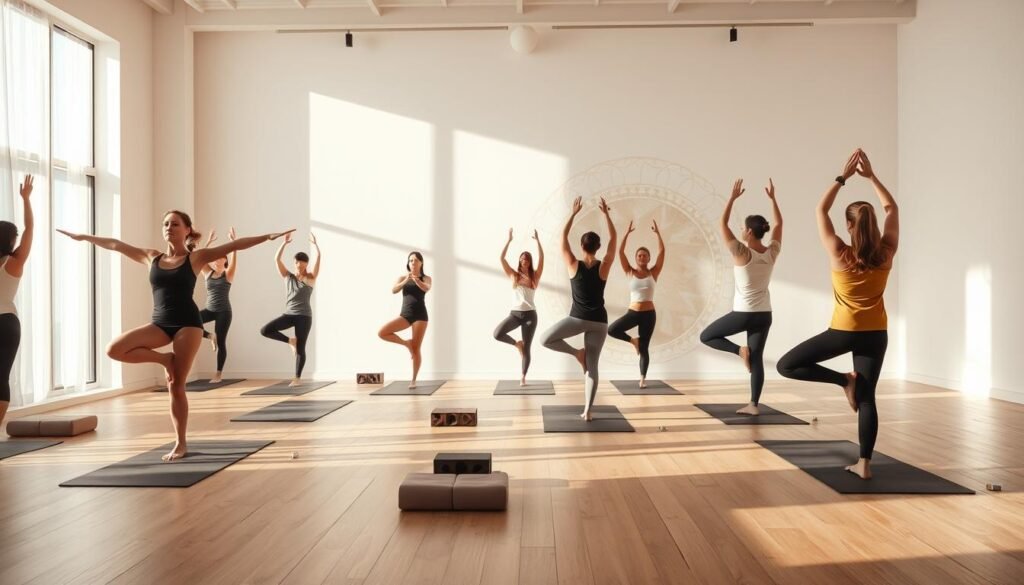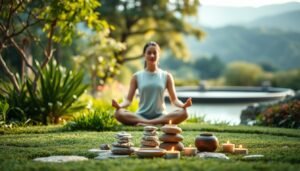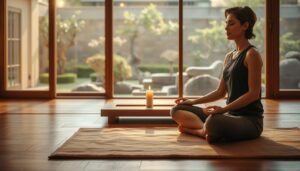Did you know that practicing yoga can reduce stress and anxiety by up to 50%? This ancient practice has been a cornerstone of wellness for thousands of years, offering a multitude of physical and mental benefits. For those looking to embark on or continue their yoga journey, having the right resources is key.
Yoga guides serve as comprehensive resources for practitioners of all levels, providing beginner yoga tips and advanced techniques. Whether you’re looking to improve flexibility, build strength, or find inner peace, these guides cover a wide range of topics and styles.
Key Takeaways
- Discover the benefits of incorporating yoga into your daily routine.
- Learn beginner-friendly yoga tips to enhance your practice.
- Explore various yoga styles to find what suits you best.
- Understand how yoga can improve mental and physical health.
- Find resources for advancing your yoga practice.
Understanding the Basics of Yoga
At its core, yoga is a holistic practice that unites the body, mind, and spirit. It is a journey that encompasses various techniques, including physical postures, breathing exercises, and meditation, to achieve a balanced and healthy lifestyle.
What is Yoga?
Yoga is often perceived as a physical practice, but it is much more than that. It is an ancient discipline that originated in India over 5,000 years ago, with roots in Hindu philosophy. The word “yoga” comes from the Sanskrit word “yuj,” meaning “to unite” or “to join.” This union refers to the integration of the individual’s consciousness with the universal consciousness.
Yoga is a practice that caters to different needs and preferences, making it accessible to people of all ages and abilities. Whether you’re looking to improve your physical health, reduce stress, or enhance your mental clarity, yoga offers a range of techniques to achieve your goals.
The Philosophy Behind Yoga
The philosophy of yoga is deeply rooted in ancient Indian texts, such as the Yoga Sutras of Patanjali. These texts outline the principles and practices of yoga, providing a framework for understanding its deeper aspects. The philosophy emphasizes the importance of ethical living, self-discipline, and self-awareness.
One of the key philosophical concepts in yoga is the idea of eight limbs of yoga, which provide a comprehensive guide to the practice. These limbs include the yamas (ethical standards), niyamas (self-discipline), asanas (physical postures), pranayama (breath control), pratyahara (sense withdrawal), dharana (concentration), dhyana (meditation), and samadhi (enlightenment or union with the divine).
Different Styles of Yoga
Over time, yoga has evolved into various styles, each with its unique focus and approach. Some of the most popular styles include Hatha Yoga, which emphasizes physical postures and breathing techniques; Vinyasa Yoga, a flowing style that links movement with breath; and Yin Yoga, a slow-paced practice that targets the deeper tissues of the body.
Other styles, such as Restorative Yoga and Kundalini Yoga, offer distinct approaches to the practice. Restorative Yoga involves using props to support the body in relaxing postures, while Kundalini Yoga focuses on the release of energy through postures, breath, and meditation.
With the rise of online yoga classes, it’s now easier than ever to explore these different styles from the comfort of your own home. Whether you’re a beginner or an experienced practitioner, there’s a style of yoga that’s right for you.
Benefits of Regular Yoga Practice
Regular yoga practice can transform your life in numerous ways, from improving physical health to enhancing mental well-being. By incorporating yoga into your daily routine, you can experience a wide range of benefits that impact both body and mind.
Physical Benefits
One of the most noticeable benefits of yoga is its impact on physical health. Regular practice can improve flexibility by increasing range of motion and reducing stiffness. Yoga also builds strength, particularly in the core, arms, and legs, through various poses and flows. Additionally, yoga helps enhance balance and coordination, reducing the risk of falls and injuries.
Other physical benefits include improved cardiovascular health, better posture, and enhanced overall physical fitness. By practicing yoga regularly, individuals can also experience weight management and improved sleep quality.
Mental and Emotional Benefits
Yoga is not just beneficial for the body; it also has a profound impact on mental and emotional well-being. Regular practice has been shown to reduce stress and anxiety by promoting relaxation and calming the mind. Yoga also enhances mood, with many practitioners reporting improved overall happiness and reduced symptoms of depression.
Furthermore, yoga can improve focus and concentration, helping individuals to stay present and mindful in their daily lives. By incorporating yoga into your routine, you can experience a greater sense of calm and well-being, leading to a more balanced and fulfilling life.
Getting Started with Yoga
Embarking on a yoga journey can be both exciting and overwhelming, but with the right guidance, you’ll be practicing like a pro in no time. As a beginner, it’s essential to start with the basics to ensure a strong foundation for your practice.
Choosing the Right Yoga Mat
One of the first steps in starting your yoga practice is choosing the right yoga mat. A good yoga mat provides the necessary grip, comfort, and support for your joints. When selecting a mat, consider the material, thickness, and texture. For example, eco-friendly mats made from natural rubber or cotton are popular choices among yogis.
A thicker mat can offer more cushioning, but may compromise on stability. On the other hand, a thinner mat provides better balance and control. Consider your personal preferences and the type of yoga you plan to practice when making your decision.
Finding a Yoga Class or Instructor
Finding the right yoga class or instructor is crucial for a fulfilling practice. Look for classes that cater to beginners and align with your goals, whether it’s yoga for flexibility, strength, or stress relief. Consider the teaching style, class size, and level of experience when choosing an instructor.
You can find yoga classes at local studios, gyms, or online platforms. Many studios offer trial classes or introductory packages for new students. Don’t be afraid to try out different classes and instructors until you find the one that feels right for you.
Additionally, online yoga classes have become increasingly popular, offering the flexibility to practice from the comfort of your own home. Look for platforms that offer a variety of classes and levels to suit your needs.
Types of Yoga Practices to Explore
Yoga encompasses a wide range of practices, each with its unique focus and benefits, catering to different goals and preferences. Whether you’re looking for a physically demanding practice or a meditative experience, there’s a yoga style suited for you.
Hatha Yoga
Hatha Yoga is a traditional and classical form of yoga that focuses on physical postures (asanas) and breathing techniques (pranayama). It’s designed to balance the body’s energy and prepare it for meditation.
A typical Hatha Yoga class involves holding postures for extended periods, allowing practitioners to develop strength, flexibility, and awareness.
Vinyasa Yoga
Vinyasa Yoga, also known as flow yoga, involves synchronizing breath with movement, flowing from one pose to another. It’s a dynamic and energetic style that builds internal heat, strength, and flexibility.
Vinyasa Yoga classes can vary significantly, from slow and meditative flows to fast-paced and challenging sequences.
Yin Yoga
Yin Yoga targets the deeper tissues of the body, such as the connective tissues, through slow-paced and meditative postures. It’s a passive practice where poses are held for extended periods to promote flexibility and release tension.
Yin Yoga is particularly beneficial for improving joint mobility and relieving stress.
Restorative Yoga
Restorative Yoga is a therapeutic practice that involves using props to support the body in relaxing postures. It’s designed to rejuvenate the body and calm the mind, promoting deep relaxation and stress relief.
This style of yoga is particularly beneficial for individuals recovering from injury or experiencing chronic stress.
| Yoga Style | Focus | Benefits |
|---|---|---|
| Hatha Yoga | Physical postures and breathing techniques | Balance, strength, flexibility |
| Vinyasa Yoga | Flowing movements synchronized with breath | Internal heat, strength, flexibility |
| Yin Yoga | Deep stretching and targeting connective tissues | Flexibility, joint mobility, stress relief |
| Restorative Yoga | Relaxation and rejuvenation using props | Deep relaxation, stress relief, rejuvenation |
Essential Yoga Poses for Beginners
For those new to yoga, starting with simple yet powerful poses is crucial for establishing a solid foundation. Beginner yoga routines often include poses that are foundational, accessible, and adaptable to different levels of practice.
Two of the most essential yoga poses for beginners are Mountain Pose (Tadasana) and Downward-Facing Dog (Adho Mukha Svanasana). These poses are not only great for building strength and flexibility but also for understanding the basic principles of alignment and breath.
Mountain Pose (Tadasana)
Mountain Pose is a foundational standing pose that teaches alignment, balance, and grounding. To practice Tadasana, stand with your feet hip-width apart, engage your core, and reach your arms towards the ground, keeping your spine long and your head level. This pose is excellent for improving posture and reducing stress.
Downward-Facing Dog (Adho Mukha Svanasana)
Downward-Facing Dog is a versatile pose that stretches the hamstrings, calves, and spine while strengthening the arms and shoulders. To practice Adho Mukha Svanasana, start on all fours, then lift your hips towards the ceiling, straightening your arms and legs as much as possible. Keep your head in a neutral position and your palms and heels grounded.
Both Mountain Pose and Downward-Facing Dog are essential yoga poses that can be modified to suit different levels of practice, making them perfect for beginners. They help build a strong foundation for more complex poses and contribute to overall flexibility and strength.
By incorporating these poses into your beginner yoga routines, you’ll be well on your way to developing a practice that is both fulfilling and challenging. Remember, the key to progressing in yoga is consistency and patience.
Creating Your Home Yoga Space
Transforming a corner of your home into a yoga sanctuary can significantly enhance your practice. A dedicated space not only fosters consistency but also creates an environment conducive to relaxation and mindfulness.
Choosing the Right Location
When selecting a location for your home yoga space, consider a quiet area with minimal distractions. Ideally, this space should be away from high-traffic areas and electronic devices that can disrupt your practice. Natural light is a plus, as it can enhance the ambiance and create a sense of calm.
The space should be large enough to accommodate your yoga mat and any additional props you might use. Even a small, clutter-free area can serve as an effective yoga space, provided it’s dedicated to your practice.
Essential Props and Accessories
To create an effective home yoga practice, certain props and accessories are essential. These not only support your practice but also enhance your overall experience.
- A high-quality yoga mat is fundamental. It provides the necessary grip and cushioning for your joints.
- Yoga blocks and straps can assist in achieving proper alignment and flexibility, especially for beginners.
- A bolster or pillow can be used for support in restorative yoga poses.
- Blankets or eye pillows can add comfort during relaxation and meditation.
| Prop/Accessory | Purpose | Benefit |
|---|---|---|
| Yoga Mat | Provides grip and cushioning | Enhances practice comfort and safety |
| Yoga Blocks | Assists in achieving proper alignment | Improves flexibility and balance |
| Straps | Deepens stretches and improves flexibility | Enhances range of motion |
By thoughtfully selecting the location and incorporating essential props, you can create a home yoga space that nurtures your body, mind, and spirit.

Yoga for Specific Goals
Yoga’s adaptability makes it an effective tool for addressing specific wellness goals. Whether you’re looking to reduce stress, improve flexibility, or build strength, yoga can be tailored to meet your needs.
Stress Relief
Yoga is renowned for its ability to reduce stress and promote relaxation. Certain yoga practices, such as Hatha Yoga and Yin Yoga, focus on slow, meditative movements that calm the mind and body.
- Child’s Pose (Balasana): A resting pose that calms the nervous system.
- Legs Up The Wall Pose (Viparita Karani): Helps to reduce swelling in the legs and promotes relaxation.
- Reclined Pigeon Pose (Supta Eka Pada Rajakapotasana): Stretches the hips and glutes, releasing tension.
Flexibility
Improving flexibility is another significant benefit of yoga. Practices like Vinyasa Yoga and Hatha Yoga involve flowing movements that enhance flexibility and range of motion.
| Pose | Benefits |
|---|---|
| Downward-Facing Dog (Adho Mukha Svanasana) | Stretches the hamstrings, calves, and spine. |
| Warrior II (Virabhadrasana II) | Strengthens the legs and hips while stretching the chest. |
| Triangle Pose (Trikonasana) | Stretches the hips, thighs, and spine, improving flexibility. |
Strength
Yoga can also be an effective way to build strength. Poses that require holding the body in specific positions, such as Plank Pose and Warrior Poses, engage various muscle groups.
- Plank Pose (Phalakasana): Engages the core, arms, and legs.
- Boat Pose (Paripurna Navasana): Strengthens the abdominal muscles.
- Warrior I (Virabhadrasana I): Builds strength in the legs and hips.
By incorporating these practices into your yoga routine, you can effectively target your specific wellness goals, whether it’s reducing stress, improving flexibility, or building strength.
Mindfulness and Meditation in Yoga
Incorporating mindfulness and meditation into yoga practice can lead to a more balanced and fulfilling experience. These elements are crucial for enhancing the benefits of yoga and deepening one’s practice.
The Significance of Breathwork
Breathwork, or the conscious control of breathing, is a fundamental aspect of yoga. It serves as a bridge between the physical and mental aspects of the practice, promoting relaxation and reducing stress. By focusing on the breath, practitioners can achieve a state of calm and concentration.
The role of breath in yoga is multifaceted. It not only aids in transitioning between poses but also helps in maintaining the correct alignment and balance. Moreover, conscious breathing can enhance the physical benefits of yoga by improving circulation and reducing muscle tension.

Incorporating Meditation into Your Practice
Meditation is a powerful tool that complements the physical aspects of yoga. By incorporating meditation into their practice, individuals can experience a deeper sense of calm, clarity, and inner peace. Meditation helps in cultivating mindfulness, which can then be applied to daily life, improving overall well-being.
To incorporate meditation into your yoga practice, start by dedicating a few minutes at the end of your session to sit quietly and focus on your breath. Gradually increase the duration as you become more comfortable with the practice. You can also explore guided meditation recordings to help you get started.
Benefits of Mindfulness and Meditation in Yoga
| Benefit | Description |
|---|---|
| Reduced Stress | Mindfulness and meditation help in managing stress by promoting relaxation and calmness. |
| Improved Focus | Regular practice of meditation enhances concentration and mental clarity. |
| Enhanced Self-Awareness | Mindfulness and meditation promote a deeper understanding of oneself, leading to personal growth. |
Advanced Yoga Techniques
Advanced yoga techniques, including inversions and arm balances, offer a new level of challenge for practitioners looking to deepen their practice. These complex poses require not only physical strength and flexibility but also mental focus and balance. As you progress, it’s essential to approach these poses with caution and patience.
Inversions for Intermediate Practitioners
Inversions are poses where your body is upside down, which can be both challenging and rewarding. Examples include Headstand (Sirsasana) and Handstand (Adho Mukha Vrksasana). These poses can help improve circulation, balance, and overall strength. However, they require careful preparation and practice against a wall to ensure safety.
To prepare for inversions, start by building your upper body strength and practicing downward-facing dog and other preparatory poses. It’s also beneficial to work on your core strength and flexibility.
| Pose | Benefits | Precautions |
|---|---|---|
| Headstand (Sirsasana) | Improves circulation, balance, and strength | Avoid if you have neck injuries |
| Handstand (Adho Mukha Vrksasana) | Strengthens arms and shoulders, improves balance | Practice against a wall for support |
Exploring Arm Balances
Arm balances, such as Crow Pose (Bakasana) and Side Crow (Parsvakonasana), challenge your strength, flexibility, and focus. These poses can help build confidence and improve your overall yoga practice.
To master arm balances, focus on building your core strength and practicing poses that open your hips and strengthen your arms. Engaging your core and maintaining a steady gaze can also help you balance in these poses.
For those interested in exploring advanced yoga techniques further, consider joining online yoga classes that cater to intermediate and advanced practitioners. These classes can provide personalized feedback and guidance as you progress in your practice.
Building a Consistent Yoga Routine
Establishing a consistent yoga practice is key to experiencing its full benefits. A well-planned routine helps in making yoga a sustainable part of your lifestyle.
Achievable Milestones
Setting realistic goals is crucial when building a yoga routine. Start by defining what you want to achieve through your practice, whether it’s improving flexibility, reducing stress, or enhancing overall well-being. Break down larger goals into smaller, manageable milestones, such as practicing yoga a certain number of times per week or mastering a specific pose.
Monitoring Progress
Tracking your progress is essential for staying motivated. Keep a yoga journal to record your practices, note your achievements, and identify areas for improvement. Regularly reviewing your progress helps in adjusting your routine as needed, ensuring you continue to grow and benefit from your yoga practice.
By setting achievable milestones and monitoring your progress, you can build a consistent yoga routine that supports your overall health and wellness goals.
FAQ
What is the best yoga style for beginners?
How often should I practice yoga to see benefits?
Can yoga help with stress relief?
Do I need to be flexible to start yoga?
What are the essential props for a home yoga practice?
Can I practice yoga at home without a class or instructor?
How can I incorporate meditation into my yoga practice?
What are some yoga poses for building strength?
How can I track my progress in yoga?
Prabir Dutta
Prabir Dutta is a passionate digital creator, affiliate marketer, and wellness enthusiast who simplifies complex topics like AI tools, Vastu, pet care, and modern living. With a keen eye for SEO, tech trends, and everyday health solutions, he writes to empower readers with actionable, smart-living insights. When not curating content across his network of niche blogs, Prabir enjoys exploring new digital tools that make life easier and more efficient.








